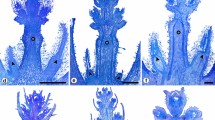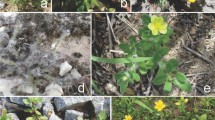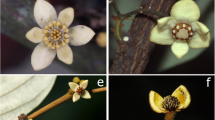Abstract
A broad comparative analysis reveals that the inflorescences of coreMalvales, familiesSterculiaceae, Tiliaceae, Bombacaceae andMalvaceae, include characteristic repeating units. The basic repeating unit is called bicolor unit (afterTheobroma bicolor, where it was first observed). It is determinate and bears three bracts, one of which is invariably sterile, whereas the others subtend lateral cymes or single flowers. Through the demonstration of intermediate steps in closely related taxa the triad of bracts within a bicolor unit and the trimerous malvalean epicalyx are shown to be homologous. Various possibilities for an origin of the bicolor unit are discussed. Bicolor units are variously arranged to form complete inflorescences. In many taxa they are terminal on modules that comprise two (or fewer) prophylls. These modules may be arranged in elongated anthocladia or condensed sympodia, which in turn may constitute components of higher order inflorescence structures. The presence of the bicolor unit or its derivatives linksSterculiaceae, Tiliaceae, Bombacaceae andMalvaceae. It is absent from all other families included in a broader defined orderMalvales and represents one of the rare morphological synapomorphies of coreMalvales. Furthermore, inflorescence morphology provides characters of systematic significance for various taxa within coreMalvales.
Similar content being viewed by others
References
Alverson, W. S., Karol, K. G., Baum, D. A., Chase, M. W., Swensen, S. M., McCourt, R., Sytsma, K. J., 1998: Circumscription of theMalvales and relationships to otherRosidae: evidence fromrbcL sequence data. — Amer. J. Bot.85: 876–887.
Bailey, W. W., 1883: Note onAbutilon. — Bull. Torrey Bot. Club10: 132.
Barnett, L. C., 1987: Tribal realignment of certain palaeotropicalSterculiaceae. — Amer. J. Bot.74: 724.
—, 1988: Systematics ofNesogordonia Baillon (Sterculiaceae). — Ph.D. Thesis, University of Texas, Austin.
Bates, D. M., 1969: Systematics of the South African genusAnisodontea Presl (Malvaceae). — Gentes Herb.10: 215–383.
Bayer, C., 1994: Zur Infloreszenzmorphologie derMalvales. — Diss. Bot.212.
—, 1996: Inflorescence morphology of some AustralianLasiopetaleae (Sterculiaceae). — Telopea6: 721–728.
Bocquillon, H., 1886: Mémoire sur le groupe des Tiliacées. — Adansonia7: 17–64.
Briggs, B. G., Johnson, L. A. S., 1979: Evolution in theMyrtaceae — Evidence from inflorescence structure. — Proc. Linn. Soc. New South Wales102: 157–256.
Chattaway, M. M., 1933: Tile-cells in the rays of theMalvales. — New Phytol.32: 261–273.
Cronquist, A., 1988: The evolution and classification of flowering plants, 2nd edn. — New York: Columbia University Press.
Dahlgren, R., 1983: General aspects of angiosperm evolution and macrosystematics. — Nordic J. Bot.3: 119–149.
Dass, H. C., Randhawa, G. S., 1962: Vascular anatomy of the flower ofGrewia asiatica L. — Phyton (Buenos Aires)19: 185–193.
Edlin, H. L., 1935: A critical revision of certain taxonomic groups of theMalvales. — New Phytol.34: 1–20, 122–143.
Eichler, A. W., 1878: Blüthendiagramme,2. — Leipzig: Engelmann.
Erdtman, G., 1952: Pollen morphology and plant taxonomy. Angiosperms. — Stockholm: Almqvist & Wiksell.
Fay, M. F., Bayer, C., Alverson, W. S., Brujin, A. Y., de, Chase, M. W., 1998: PlastidrbcL sequence data indicate a close affinity betweenDiegodendron andBixa. — Taxon47: 43–50.
Fuchs, H., 1967: Pollen morphology of the familyBombacaceae. — Rev. Palaeobot. Palynol.3: 119–132.
Goldberg, A., 1967: The genusMelochia L. (Sterculiaceae). — Contr. U.S. Natl. Herb.34: 191–363.
Heel, W. A. van, 1966: Morphology of the androecium inMalvales. — Blumea13: 177–394.
Huber, H., 1991: Angiospermen. Leitfaden durch die Ordnungen und Familien der Bedecktsamer. — Stuttgart, New York: G. Fischer.
Hutchinson, J., 1967: The genera of flowering plants (Angiospermae),2. — Oxford: Clarendon Press.
Jenny, M., 1985: Struktur, Funktion und systematische Bedeutung des Gynoeciums bei Sterculiaceen. — Diss., Universität Zürich.
Kearney, T. H., 1951: The American genera ofMalvaceae. — Amer. Midl. Naturalist46: 93–131.
Macloskie, G., 1884: The involucre inMalvaceae. — Bull. Torr. Bot. Club11: 8.
Manchester, S. R., 1980:Chattawaya (Sterculiaceae): a new genus of wood from the Eocene of Oregon and its implications for xylem evolution of the extant genusPterospermum. — Amer. J. Bot.67: 59–67.
—, 1978: Tile cells and their occurrence in malvalean fossil wood. — I. A. W. A. Bull.1978/2–3: 23–28.
Metcalfe, C. R., Chalk, L., 1950: Anatomy of the dicotyledons,1. — Oxford: Clarendon Press.
Payer, J.-B., 1857: Traité d'organogénie comparée de la fleur. — Paris (reprint 1966, Lehre: Cramer).
Schröter, C., 1883: Beitrag zur Kenntniss des Malvaceen-Androeceums. — Jahrb. Königl. Bot. Gart. Berlin2: 153–165.
Schumann, K., 1886a:Sterculiaceae. — InMartius, C. F. P. de (Ed.): Flora Brasiliensis,12(3). — München.
—, 1886b: Vergleichende Blütenmorphologie der cucullatenSterculiaceae. — Jahrb. Königl. Bot. Gart. Berlin4: 286–332.
—, 1895:Elaeocarpaceae, Tiliaceae, Malvaceae, Bombacaceae, Sterculiaceae. — InEngler, A., Prantl, K., (Eds): Die natürlichen Pflanzenfamilien,3(6), pp. 1–99. — Leipzig: Engelmann.
Sharma, B. D., 1970: Contribution to the pollen morphology and plant taxonomy of the familyBombacaceae. — Proc. Indian Natl. Sci. Acad. B36: 175–191.
Szyszylowicz, I. von, 1885: Zur Systematik der Tiliaceen I. — Bot. Jahrb. Syst.6: 427–457.
Takhtajan, A., 1997: Diversitiy and classification of flowering plants. — New York: Columbia University Press.
Tang, Y., 1992: The systematic position ofCorchoropsis Sieb. etZucc. — Cathaya4: 131–150.
Thorne, R. F., 1992: Classification and geography of the flowering plants. — Bot. Rev.58: 225–348.
Troll, W., 1964: Die Infloreszenzen. Typologie und Stellung im Aufbau des Vegatationskörpers,1. — Stuttgart: G. Fischer.
Venkata Rao, C., 1952: Floral anatomy of someMalvales and its bearing on the affinities of families included in the order. — J. Indian Bot. Soc.31: 171–203.
Weberling, F., 1989: Morphology of flowers and inflorescences. — Cambridge: Cambridge University Press.
-Herkommer, U., 1989: Untersuchungen zur Infloreszenzmorphologie der Thymelaeaceen. — Trop. Subtrop. Pflanzenwelt68.
Wydler, H., 1859: Kleinere Beiträge zur Kenntniss einheimischer Gewächse. — Flora42: 336–345, 353–368, pl. 6.
Zebe, V., 1915: Monographie der Sterculiaceen-GattungenKleinhovia, Helicteres, Reevesia, Ungeria undPterospermum (Allgemeiner Teil). — Diss., Universität Breslau.
Author information
Authors and Affiliations
Rights and permissions
About this article
Cite this article
Bayer, C. The bicolor unit — homology and transformation of an inflorescence structure unique to coreMalvales . Pl Syst Evol 214, 187–198 (1999). https://doi.org/10.1007/BF00985738
Received:
Revised:
Accepted:
Issue Date:
DOI: https://doi.org/10.1007/BF00985738




